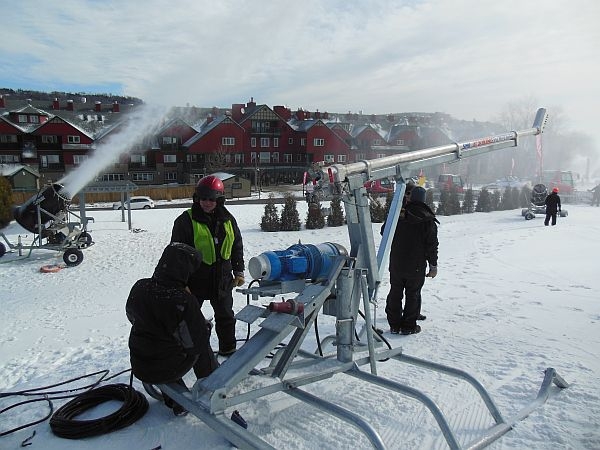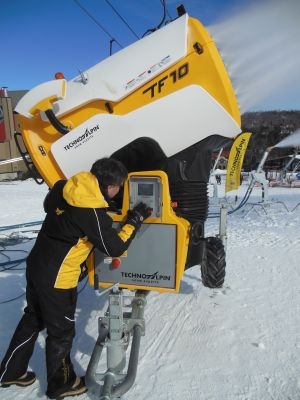
Ski resorts can have the most luxurious lodges, the fastest lifts and most exciting terrain. But if they don’t have snow in the winter, none of that matters much. It’s why so many resorts invest heavily in snowmaking. It’s a technology that’s come a long way since it’s inception nearly 70 years ago.
When you hear skiers and riders whooping it up on a Vermont ski slope, chances are you’ll also hear the high pressure hiss of a snow gun not far away. According to the Vermont Ski Areas Association, Vermont ranks number one in the nation for snowmaking with almost 80% of its slopes using the technology.
There’s an interesting story to snowmaking. Exactly when it was discovered is sketchy, but sometime in the 1940s Canadian researchers were testing de-icing equipment on airplane engines. To produce field conditions, the researchers came up with various nozzles to spray out freezing rain, fog, sleet and what they later described in scientific journals as "snow."
David Moulton, Operations Director at Mount Snow says "They ended up making snow purely by accident. So much by accident that they occasionally had to shut down the engine and shovel out the wind tunnel and start back up again."
Now you might think this could have been one of those ah-ha moments when someone in that wind tunnel called a patent attorney and made a fortune in a new line of work. "But no," says Moulton, "they didn’t know what they had at that point. They were purely interested in manufacturing engines and proving them and they never took it any further." Moulton says, they weren’t interested in making snow they never patented it and it was mostly just a flash in the pan at that point."
The story picks up, according to the New England Ski Museum, with Wayne Pierce and the Tey Manufacturing Company of Milford, Connecticut.
The company initially made skis, but a sales slump from lack of snow in the late 40s, pushed Pierce to begin tinkering with a paint spray compressor, a nozzle and some garden hose.
Walter Schonknecht, the founder of Mowalk Mountain in Connecticut – and later Mount Snow in Vermont – knew Pierce and invited him to test his new invention on the slopes. It worked!
Pierce filed a patent application for his snow gun in 1950 and over the next two decades various improvements were made and other companies got involved.
But Joe Vanderkeller, President of SMI Snowmakers in Michigan, says it wasn’t until the 1970s that the snowmaking industry really took off after several particularly bad snow years. "I think that’s when snowmaking got serious," says Vanderkeller. "Research and development started happening and it really became a business," he says, "and it’s a big industry globally."
Worldwide, Vanderkeller says the industry today generates hundreds of millions of dollars a year. "When you look at the distribution systems, the lakes that are built, the pumps and compressors that are bought, the piping and distribution that’s put on the mountains and then the snow guns which are fancy irrigation heads if you will." But he says "they’re very technical and complicated because they have to work in cold temperatures and get that crystal to freeze."
Manufacturers like SMI show off their wares at annual ski industry events. This year they met at Mount Snow where Martin Rochon, was checking out some of the new fan style models.
Rochon is director of operations at Mt Tremblanc in Quebec. He says with hundreds of millions of dollars invested in snowmaking, it’s vital for his resort to stay current. "There’s definitely new products like this guy over there – that fan is new. It allows you to push snow further – so you can make snow on a wider surface. You spend less time pushing the snow with the machines," says Rochon, "if it’s well spread, so you also gain on the grooming side of things – that helps lessen maintenance."
Rochon says improvements in energy efficiency over the last ten years have been amazing. For instance he says with the same amount of energy they needed to run one snow gun a decade ago, they can now run 7. "So huge developmental improvements have been made," he says. "And the future is automation. . . to be able to remotely control that equipment to make the turnaround quicker to make snow." 
A few feet away, Steve Daly, of Italian based TechnoAlpin, nods. "So this is one of our latest versions – it’s a T-40 – a fully automatic snow gun."
Which means you could practically run it from your couch at home says Daly. "Each unit has it’s own weather station. It gives you ambient temperature, wet bulb temperature adding in the humidity." Daly points out features on the computer interface, "you can set this gun up with the specs that you want," he says. "You an have it start up on it’s own. We do have the smart phone capabilities blue tooth capabilities – it’s a very efficient gun ."
Fully loaded, the T-40 costs about 35-thousand dollars. Daly says this sort of equipment will soon be the norm not the exception. "You get down into lower New York, Pennsylvania, Virginia, Maryland, North Carolina it is all about automation because their windows are so short." Daly says, "if they have a 2 or 3 hour window to make snow, the automation can be on in 10 minutes, and you’re making snow." He says "you don’t have to send a crew of guys out to start up a bunch of guns that takes 2 hours."
David Moulton, Operations Director at Mount Snow says Mount Snow has invested over $10 million in snowmaking upgrades since 2007 and they plan to invest another $20 million over the next few years.
He says so far, the upgrades are saving them a bundle – like the 200-thousand gallons of diesel fuel they no longer have to buy every year to power up air compressors. "And," he says, "the emissions that go with those were completely eliminated by going with the more efficient fan gun technology."
But it’s not just ski resorts that are buying snowmaking equipment. Homeowners can buy small backyard snow guns for as little as $500.
And Joe Vanderkeller of SMI says about 5% of his business goes to auto makers for winter driving tests as well as other laboratories that test things like airplane engines. . . . funny how things come full circle.